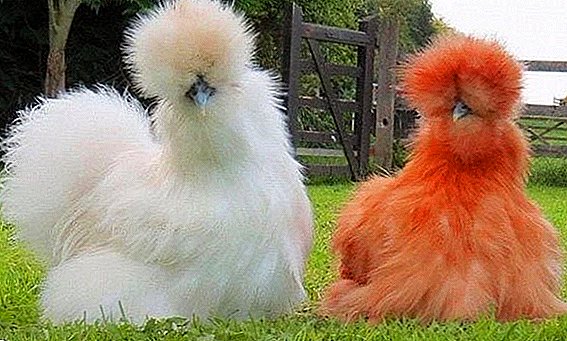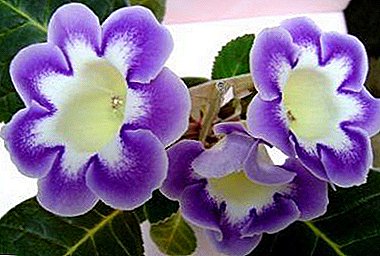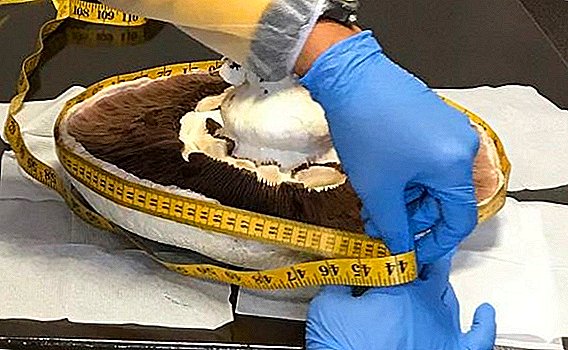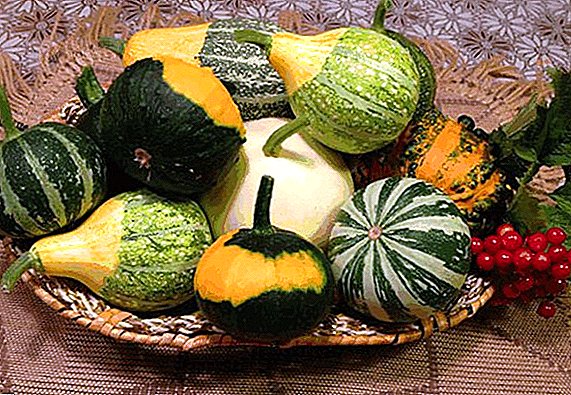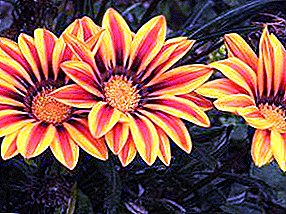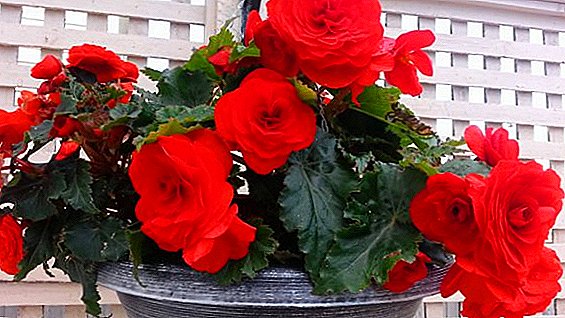 Among the indoor plants, begonia is one of the most beloved ones, because it is distinguished not only by its beautiful flowering, but also by very attractive leaves. But the care of this plant requires a lot, so below we will discuss the most famous diseases of begonias and errors in its cultivation.
Among the indoor plants, begonia is one of the most beloved ones, because it is distinguished not only by its beautiful flowering, but also by very attractive leaves. But the care of this plant requires a lot, so below we will discuss the most famous diseases of begonias and errors in its cultivation.
Problems with leafy begonias due to improper growing conditions and care for them
 Most often, problems with growing begonias arise because of the fact that the flower is improperly looked after. As a result, he begins to lose its attractiveness, ceases to develop. The main symptoms and causes of the disease begonias are described below.
Most often, problems with growing begonias arise because of the fact that the flower is improperly looked after. As a result, he begins to lose its attractiveness, ceases to develop. The main symptoms and causes of the disease begonias are described below.
Begonia leaves curl and dry around the edges
A similar reaction may develop in a plant due to excessively dry conditions of the content, when it does not receive enough moisture either from air or from the soil. In order for the leaves to recover as soon as possible, begonia needs to be watered and removed from the window sill with too bright light.
New leaves begonias small
Begonia - This plant, which is very demanding on the nutritional value of the soil. Therefore, even if you regularly transplant it and use fresh soil mixture, closer to winter, the plant may have very small new leaves.
In this case, begonia is recommended to feed a little. For this purpose, ideal liquid fertilizer intended for flowering houseplants. The complex composition of such fertilizing will be useful to the plant every two weeks.
Plant drooped, begonia leaves bowed
 If the begonia has fallen, its leaves become lethargic and unattractive, then, most likely, the content of begonia in the kitchen, where a gas stove is regularly used, has led to this.
If the begonia has fallen, its leaves become lethargic and unattractive, then, most likely, the content of begonia in the kitchen, where a gas stove is regularly used, has led to this.
Unfortunately, this plant is very sensitive to gas combustion products. Therefore, the only thing that can be done in such a situation is to move the flowerpot to another, well-ventilated room.
Stem and apical rot at the base of the begonia
Most often, fans of this plant are faced with the fact that the roots of begonia rot, but often the stem part begins to rot. Cause - This is an excessive hydration of the plant, as a result of which a lot of water accumulates in its stems and leaves.
Begonia can recover only if it is put on a place well-lit by the sun, and also significantly reduce watering so that the earth can dry out a little.
In winter, begonia leaves fall.
 If in winter the leaves of the begonia faded and began to fall, it means that the room is too cool, or from the window on which the plant stands, most likely it is blown with a cold wind. To prevent the plant from losing all its leaves, move it to more comfortable conditions, or at least cover windows with drafts.
If in winter the leaves of the begonia faded and began to fall, it means that the room is too cool, or from the window on which the plant stands, most likely it is blown with a cold wind. To prevent the plant from losing all its leaves, move it to more comfortable conditions, or at least cover windows with drafts.
Diseases of decorative and hardwood begonias
Begonia diseases can spread from other plants as well as from poor soil collected in the garden, or from a non-disinfected pot, or even pruning tools. Often, this leads to the wrong care.
Yellow rings and spots on the leaves of begonia
Unfortunately, with the manifestation of a similar symptom, it is better to destroy the plant. The fact, that yellow rings and spots, which subsequently lead to leaf deformation, leaves the plant cucumber mosaic virus.
There is no means of dealing with it, but now it is spreading fairly quickly and actively, so if you have it, try to immediately destroy the source of its distribution.
Gray mold
 Gray rot or mold on the stems and leaves of the plant appears as a greenish with a slight tinge of brown powder coating. Often it affects not only the leaves, but also the flowers of begonias, for which reason it is necessary to fight the mold urgently.
Gray rot or mold on the stems and leaves of the plant appears as a greenish with a slight tinge of brown powder coating. Often it affects not only the leaves, but also the flowers of begonias, for which reason it is necessary to fight the mold urgently.
To get rid of mold, plant treated with benomyl. In addition, since mold is most often formed due to excessive humidity, it is better to rearrange the plant in a dry and cool room for the period of "treatment".
Important! Begonia loves the lighted places in which it will develop well and bloom brightly. But it should be remembered that, with direct sunlight on its leaves, they can burn and dry.
Mealy dew
 If the plant has struck this disease, white spots with powdered powder will rapidly form on its leaves and stems. To stop the development of the disease, be sure to treat the plant with fungicides.
If the plant has struck this disease, white spots with powdered powder will rapidly form on its leaves and stems. To stop the development of the disease, be sure to treat the plant with fungicides.
It will also be useful to transfer the flower to a well-ventilated, cool room, because in such conditions, the powdery mildew practically does not appear and does not spread.
Black root rot
 If you notice that your favorite begonia has essentially stopped growing, and it starts to fade, you can try to transplant it. If in the process of transplantation you see blackened and rotting roots, the plant suffers from black root rot.
If you notice that your favorite begonia has essentially stopped growing, and it starts to fade, you can try to transplant it. If in the process of transplantation you see blackened and rotting roots, the plant suffers from black root rot.
To cope with it will help all the same spraying benomil. To prevent the development of such a disease, control watering and in no case re-moisten the soil in the pot.
Problems with blooming begonia due to improper growing and care conditions
During the flowering period, begonia requires the most attention, as the plant requires an adequate amount of nutrients, moisture and sunlight for the active growing season. But since begonia is very picky in this matter, not everyone can guess her wishes.
Begonia does not bloom, new leaves are small
Lack of flowering and poor development - this is evidence of a lack of nutrients in the soil. Therefore, try to transplant begonia in fresh soil, as well as fertilize every two weeks. Soon the plant will go back to active growth and may bloom even out of season.
Begonia leaves dry and sluggish
 The lethargy and complete drying of the leaves are caused by growing begonias in excessively dry conditions. It should be understood that this plant is very demanding of high humidity and moisture at the roots. Therefore, try not to overdry the air in the room with begonia and water it regularly.
The lethargy and complete drying of the leaves are caused by growing begonias in excessively dry conditions. It should be understood that this plant is very demanding of high humidity and moisture at the roots. Therefore, try not to overdry the air in the room with begonia and water it regularly.
Did you know? Begonia is a houseplant that can delight in flowering in both summer and winter. But it attracts attention not only with flowers, but also with attractive large pubescent leaves, which can have a multi-colored color.
Begonia leaves turned yellow and drooped
It is often found that the begonias do not just drop the leaves, but they also turn yellow. Such behavior of the plant will indicate that it is overly intensively watered and at the same time kept in cold conditions. Flowering from this can also disappear gradually, if at all able to appear.
In this case, for some time you should leave the plant without watering, and also move it closer to heat. Try not to go to extremes and not to overdry begonia, which will lead to the appearance of dry leaves.
Rot at the base of the stems of begonia
 Rot at the base of the stems is a consequence of excessive moisture. In this case, the soil is recommended to dry well and in the future to avoid waterlogging. In especially severe cases, when you notice the development of rot too late, the plant may not even recover, so you should monitor watering regularly.
Rot at the base of the stems is a consequence of excessive moisture. In this case, the soil is recommended to dry well and in the future to avoid waterlogging. In especially severe cases, when you notice the development of rot too late, the plant may not even recover, so you should monitor watering regularly.
Rot on leaves, flowers or buds of begonias
If the begonia begins to rot not from the stalks and its base, but from the leaves, flowers and even buds - this indicates that you have sprayed this plant too often, which is not recommended in principle. Begonia should be watered only directly into the pot, because this flower does not know how to fight excess moisture and begins to rot.
Diseases of the blooming begonia
It is most unpleasant to encounter begonia diseases in the period of its active flowering, since the diseased plant completely loses its attractiveness. If at the same time during not start to eliminate these problems, the plant may die.
Bacterial wilt
The black spots on the leaves of the begonia that are in bloom are the result of a disease called bacterial wilt. 
It should be noted that it develops gradually: at first, only blistering spots appear on the leaves, which, although they are small in size, tend to grow and merge over time. Over time, these spots on the leaves become black.
The only thing that can help to cope with the disease is spraying systemic fungicidewhich can be done even for non-affected plants as a preventative measure.
Important! The main pest of begonias is excessive moisture. For this reason, even in a hot summer, it is necessary to water the plant only after 1-1.5 cm of soil dries out from the water. Under no circumstances should water be allowed to stand in a pan.
Downy mildew
 We have already talked about powdery mildew.
We have already talked about powdery mildew.
However, there are also downy mildew, in which the leaves are covered with white, soft to the touch spots.
You can cope with it the same way as with ordinary powdery mildew - using systemic fungicides.
Botrytis
Brown and black spots on the begonia leaves, which also cause them to rot, is a disease called botrytis. It develops in the event that the flower is grown in a poorly ventilated area, and also filled with water.
True, a change in growing conditions is not capable of helping begonias. To get rid of the disease, the plant should also process Benomil.
The main pests of begonias: how to deal with them?
But even more dangerous for plants are pests. It is possible and necessary to fight them, but each pest must first be recognized correctly so that you can choose an effective method of control.
Whitefly Hothouse
 It appears in conditions of high humidity and settles on the leaves of begonia, feeding on its juice. If the begonia leaves become discolored and gradually begin to shrink - most likely you will have to deal with greenhouse whitefly.
It appears in conditions of high humidity and settles on the leaves of begonia, feeding on its juice. If the begonia leaves become discolored and gradually begin to shrink - most likely you will have to deal with greenhouse whitefly.
To cope with it will help soap solution (per 10 liters of water 40 g of liquid soap). But it is necessary to carefully spray the plant with such a solution so that soap in large quantities does not fall under the roots.
Did you know? Begonia can be propagated in three ways at once: cuttings from the leaves, reproduction of the bush and cuttings from the shoots. However, when using each of them it is worth considering that the materials need to be taken only from a healthy plant.
Gallic nematode
If on the stems, roots and leaves began to appear incomprehensible growths and bloating - means, settled on begonias gall nematode.
Unfortunately, these microscopic worms are able to completely infect a plant, stop its growth and even cause complete rotting. At the same time, it is much easier to prevent the appearance of nematodes than to eliminate it.
 Therefore, before planting begonias, it is imperative that the soil be doused with steam to kill all the larvae in it. If the nematode has already been noticed - the affected areas should be removed, and the plant watered at the root a solution of Heterofos 0.05-0.2%, pouring on the area of one pot only 100 ml.
Therefore, before planting begonias, it is imperative that the soil be doused with steam to kill all the larvae in it. If the nematode has already been noticed - the affected areas should be removed, and the plant watered at the root a solution of Heterofos 0.05-0.2%, pouring on the area of one pot only 100 ml.
Soft snood
This is a very dangerous pest, as it settles almost inside the shoots, completely stopping their growth and leading to drying of the begonia. To get rid of the false shield, it should be manually cleaned from the affected areas with a soft brush. Will also effectively use infusion of garlic.
Red spider mite
The fact that your begonia parasitic spider mite, will indicate the presence of a thin web. If he has already started to hit the plant, its leaves will become marble in color, will be covered with cobwebs, will begin to turn yellow and gradually fall off.
 A tick appears only in those cases when abundant watering of the plant is combined with the content of begonias in very warm conditions.
A tick appears only in those cases when abundant watering of the plant is combined with the content of begonias in very warm conditions.
To combat the tick fit drug deciswhich should spray the affected plant. Keep in mind that the parasite likes to live on the back of the lower leaves.
Aphid greenhouse
Aphid is dangerous in that it feeds on sap from the leaves of begonias, therefore, when it is widespread, it can destroy the plant very quickly.
Evidence that the begonia struck the greenhouse aphid are yellowed and twisted leaves, which can fall together with the buds.
Aphids reproduce very intensively, and can even get into an apartment through an open window, since many of its individuals can fly. To cope with it will help drugs Actellic and Fufanon.
Important! It is necessary to fight with aphids urgently, because besides the fact that she herself can cause significant harm to begonias, a soot mushroom also likes to settle on her excrement.
Leaf nematode
Unlike the gall nematode, leaf strikes the upper part of the plant. You can learn this nematode by the light green spots on the leaves that turn brown with time.
It is almost impossible to fight the leaf nematode, although in the early stages spray begonia with a solution of Heterofos with a concentration of 0.05-0.2%. But if the damage is strong - it is better to remove the flower, and the pot is well sanitized before planting another plant.
Thrips greenhouse
 This is a fairly large insect that can be seen immediately after settling on a begonia. This pest also leads to discoloration of the leaves of the flower, makes it unsightly and stops growth.
This is a fairly large insect that can be seen immediately after settling on a begonia. This pest also leads to discoloration of the leaves of the flower, makes it unsightly and stops growth.
Thrips breed especially intensively at high humidity and high temperature, that is, in summer, and when growing begonias near heaters.
To combat the parasite is recommended to use soap solution, or insist in 1 liter of water 100 g of a mixture of tobacco and celandine.
As you could see, it is really difficult to grow begonia, but if you learn all the rules of plant care in advance and also treat it carefully during transplantation, it will not be difficult for you to avoid all the above problems. And if any begonia disease manifests itself - you already know how to eliminate it.


